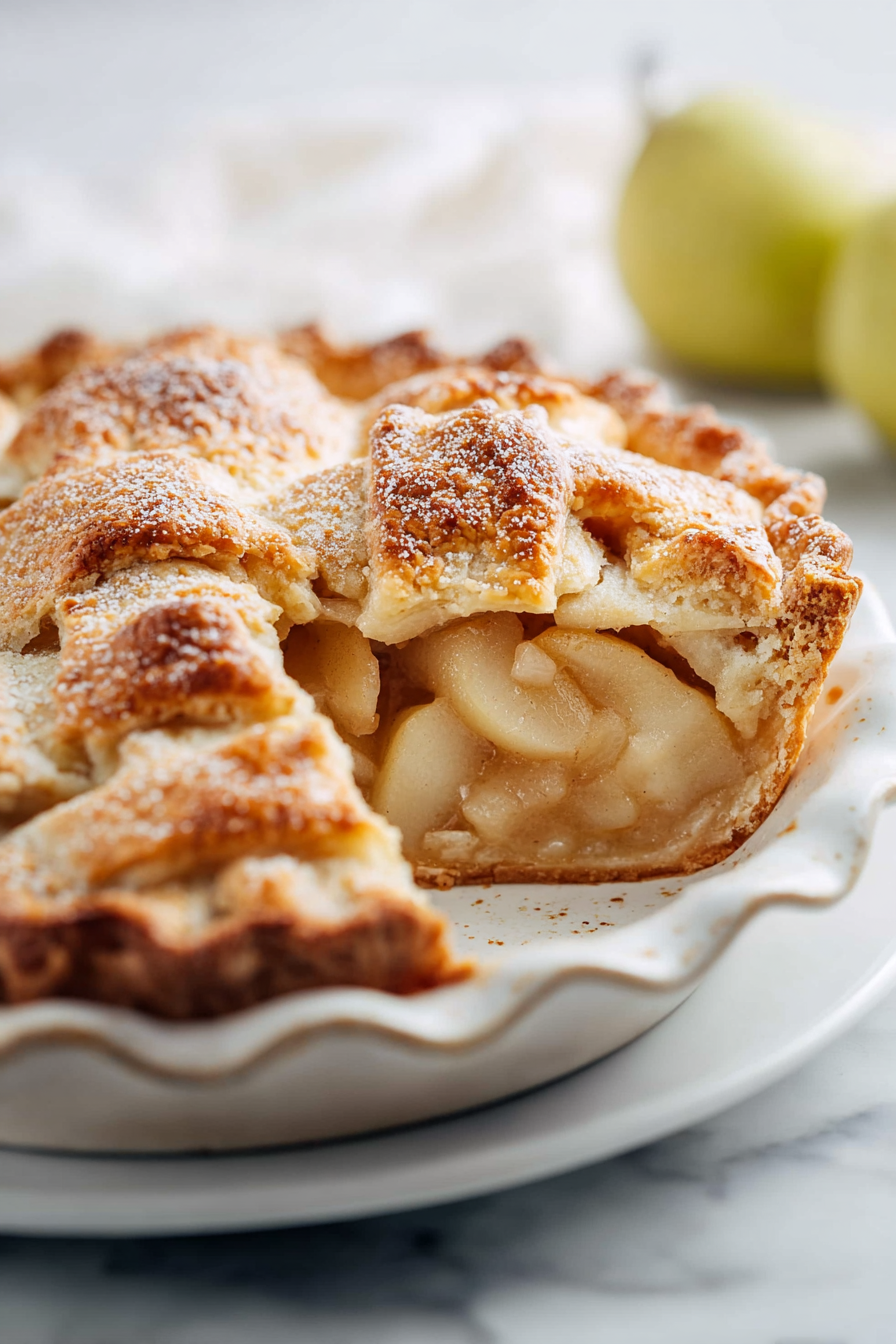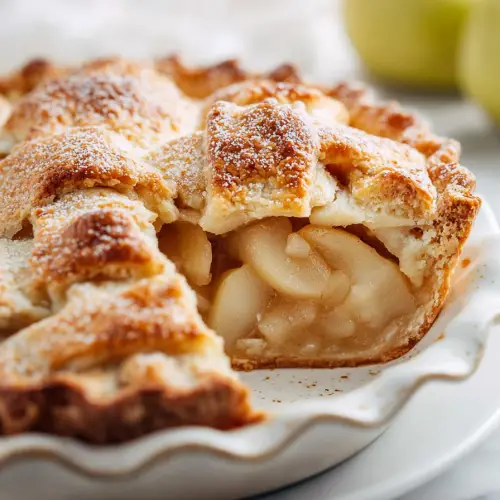Easy Pear Pie Recipe

There’s a comfortable hush to pear season in my kitchen—the kind of quiet that makes you slow your breathing without even noticing. This is an easy pear pie, the sort that smells like cinnamon and a porch swing in late afternoon, buttery crust flaking in small, satisfying sighs. It’s simple enough for a midweek mood lift and special enough for a lazy Sunday when the light pools on the countertop and everything else feels optional. I make it when I want dessert but also want a gentle, fruit-forward moment: soft pear slices glazed into a golden cradle of pastry, the house warming up like it’s wrapping itself in a blanket.
My husband calls it “autumn in a slice,” which I’ll admit makes me smile every time. Our little one has a habit of sneaking a warm wedge with a fork and then running off across the living room with caramel flecks on their chin, and our old golden retriever sits very politely by the oven, nose twitching as if he remembers every pie he’s ever loved. I’ll often start the pie with a half-drunk cup of coffee on the counter, steam still lifting in lazy spirals, and soft music on low. You know those days when something small—like a pie—feels like the whole plan? This is one of those. There have been tiny mishaps: a crust edge that slid off and became an impromptu snack for the dog, a shy pear that needed an extra minute in the skillet. All of it is part of the warm, imperfect payoff.
MORE OF OUR FAVORITE…
Why You’ll Love This Easy Pear Pie Recipe
– It’s forgiving. Pears are forgiving fruit; they soften into silk without needing perfection, so a slightly under-ripe or very ripe pear will usually find its way into something lovely. The aroma that fills the house—subtle spice, browned butter notes, the brightness of the fruit—pulls people into the kitchen before you even slide it from the oven.
– Texture plays beautifully here. There’s a tender, almost custardy fruit layer against a flaky, buttery crust that flakes and crumbles just enough to be comfortingly messy. If you like that gentle contrast of soft and crisp, this will be a quiet joy.
– It’s slow in the best way. The pie asks for a little patience—time for juices to mingle, for the edges to turn a warm, sunlit brown—but it doesn’t demand complicated techniques. That’s a rare and cozy thing: something that feels homey without a long list of rules.
Slow Moments
There are rituals that belong only to making this pie. I like to stand at the counter with a small bowl of sugar and cinnamon, tasting the mix as if it’s a secret I’m about to whisper to the pears. My son likes to scatter flour on the rim of the bowl so it looks like a winter morning; he thinks it’s decoration. The dog pads around, hoping for a drop of crust, and my husband hums an old song from the radio while he sets the timer. The kitchen is warm and the windows fog up a little; I wipe a streak with my sleeve and then leave it, because those little streaks of life are part of the memory.
I fold the dough with slow hands, letting small imperfections be part of the charm. There’s a moment when the fruit hits the hot pan and the juices begin to sing, a soft hiss that always feels like the pie saying it’s ready to become something. I’ll taste a sliver of pear, still warm from the skillet, and it feels like stealing a secret. That’s the magic: nothing flashy, just attention and time and tiny, repeated acts that add up to something comforting.
Time-Saving Hacks
– Use store-bought pie dough on especially rushed mornings. Honest, it’s still cozy and the flavor is there when you add good butter and a little extra care.
– Slice the pears a day ahead and keep them in a bowl tossed with a splash of lemon juice to prevent browning. It makes assembly on baking day so much quieter.
– If the crust looks like it’s browning too quickly, tent with foil—simple and away you go.
– Preheat your stone or baking sheet so the bottom gets that quick, warm lift; it saves you from a soggy base without fuss.
– And a calm reminder: slowing the process by even a few minutes—letting pears macerate, resting the dough—usually makes the result worth the extra time.
Serving Ideas
– For slow weekends, I love a generous scoop of vanilla ice cream melting at the edge of each slice, the cold and cream offsetting the warm, spiced pears. Add a drizzle of caramel if you’re feeling indulgent.
– For weekday simplicity, a wedge with a dollop of plain yogurt or a smear of crème fraîche makes a gentle, not-too-sweet treat that’s lovely with afternoon tea.
– Try it with a cup of medium-roast coffee in the morning or chamomile in the evening; the flavors are soft and companionable.
– If you like to pair it with other recipes, this pie sits nicely after a simple roast chicken dinner or alongside a salad of bitter greens and toasted walnuts—something bright and green to balance the sweetness.
Tips & Mistakes
I once thought I could skip brushing the top with a little beaten egg—an experiment in “rustic” looking pie—and ended up with a dull, shy crust. Lesson learned: that tiny egg wash gives you the sunlit finish that makes people pause. Another time I layered slices too thick and the center stayed a little undercooked; thinner, even slices are my new best friend. If your pears are very juicy, don’t be afraid to toss them in a small handful of flour or cornstarch to help thicken the filling; I do this quietly and feel like a kitchen wizard every time it works. And if the edges of your crust brown too quickly, tent with foil—no judgment, just comfort.
Storage Tips
Leftovers are a small, easy pleasure. I like slices at room temperature the next day, eaten with coffee while the house wakes up. Reheat gently in a low oven for ten minutes if you want the crust crisp again; the filling comes back to life without turning into a puddle. Cold slices are perfectly fine too—sweet, slightly firmer, and excellent with a cup of tea. If you need to store it longer, cover and refrigerate for a few days, or slice and freeze individual pieces on a tray before wrapping for longer keeping.
Variations and Substitutions
I’ve swapped pears for apples when I’m leaning into tartness, and it works—though pears bring a softness apples don’t. A touch of citrus zest—lemon or orange—adds brightness if your pears are very sweet. For a nutty lift, sprinkle chopped toasted almonds or pecans over the filling before the top crust goes on; it adds a little sound and a lot of comfort. I tried a whole-wheat crust once for extra earthiness; it’s denser but very cozy with a drizzle of maple. If you like spice, a whisper of cardamom beside the cinnamon gives a lovely aromatic note. Some things didn’t quite fit my kitchen: star anise felt too showy, and rhubarb with pears tilted the flavor profile too sour for our taste, though your mileage may vary.

Frequently Asked Questions

Easy Pear Pie Recipe
Ingredients
Main Ingredients
- 6 cups sliced pears Use ripe pears for the best flavor.
- 1 cup sugar Adjust the sweetness according to your preference.
- 0.5 teaspoon ground cinnamon
- 1 tablespoon lemon juice Freshly squeezed is best.
- 2 tablespoons cornstarch
- 1 package pie crust Store-bought or homemade.
Instructions
Preparation Steps
- Preheat your oven to 375°F (190°C).
- In a large bowl, combine sliced pears, sugar, cinnamon, lemon juice, and cornstarch.
- Pour the pear mixture into the pie crust.
- Cover the pie with another crust, seal, and cut slits for steam to escape.
- Bake for 45 minutes or until the crust is golden brown.
